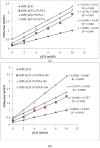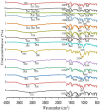Effect of Hydrophilic Polymers on Complexation Efficiency of Cyclodextrins in Enhancing Solubility and Release of Diflunisal
- PMID: 32679660
- PMCID: PMC7408593
- DOI: 10.3390/polym12071564
Effect of Hydrophilic Polymers on Complexation Efficiency of Cyclodextrins in Enhancing Solubility and Release of Diflunisal
Abstract
The effects of three hydrophilic polymers, namely, carboxymethyl cellulose sodium (CMC-Na), polyvinyl alcohol (PVA) and poloxamer-188 (PXM-188) on the solubility and dissolution of diflunisal (DIF) in complexation with β-cyclodextrin (βCD) or hydroxypropyl β-cyclodextrin (HPβCD), were investigated. The kneading method was used at different drug to cyclodextrin weight ratios. Increases in solubility and drug release were observed with the DIF/βCD and DIF/HPβCD complexes. The addition of hydrophilic polymers at 2.5, 5.0 and 10.0% w/w markedly improved the complexation and solubilizing efficiency of βCD and HPβCD. Fourier-transform infrared (FTIR) showed that DIF was successfully included into the cyclodextrin cavity. Differential scanning calorimetry (DSC) and X-ray diffractometry (XRD) confirmed stronger drug amorphization and entrapment in the molecular cage of cyclodextrins. The addition of PVA, CMC-Na or PXM-188 reduced further the intensity of the DIF endothermic peak. Most of the sharp and intense peaks of DIF disappeared with the addition of hydrophilic polymers. In conclusion, PXM-188 at a weight ratio of 10.0% w/w was the best candidate in enhancing the solubility, stability and release of DIF.
Keywords: complexation; diflunisal; dissolution rate; hydrophilic polymers; hydroxypropyl β-cyclodextrin; β-cyclodextrin.
Conflict of interest statement
There is no conflict of interest among the listed authors.
Figures








Similar articles
-
Solubility and Dissolution Enhancement of Dexibuprofen with Hydroxypropylbetacyclodextrin (HPβCD) and Poloxamers (188/407) Inclusion Complexes: Preparation and In Vitro Characterization.Polymers (Basel). 2022 Jan 31;14(3):579. doi: 10.3390/polym14030579. Polymers (Basel). 2022. PMID: 35160569 Free PMC article.
-
Binary inclusion complexes of diflunisal with β-cyclodextrin and hydroxypropyl-β-cyclodextrin: Preparation and characterization.Pak J Pharm Sci. 2020 Sep;33(5(Supplementary)):2307-2315. Pak J Pharm Sci. 2020. PMID: 33832905
-
Effect of hydrophilic polymers on isradipine complexation with hydroxypropyl β-cyclodextrin.Drug Dev Ind Pharm. 2013 Jul;39(7):970-7. doi: 10.3109/03639045.2012.686508. Epub 2012 May 21. Drug Dev Ind Pharm. 2013. PMID: 22612875
-
Influence of hydrophilic polymers on celecoxib complexation with hydroxypropyl β-cyclodextrin.AAPS PharmSciTech. 2006 Sep;7(3):E184-E189. doi: 10.1208/pt070379. Epub 2017 Mar 8. AAPS PharmSciTech. 2006. PMID: 28290014
-
Effect of beta-cyclodextrin and hydroxypropyl beta-cyclodextrin complexation on physicochemical properties and antimicrobial activity of cefdinir.J Pharm Biomed Anal. 2008 Jul 15;47(3):535-40. doi: 10.1016/j.jpba.2008.02.006. Epub 2008 Feb 15. J Pharm Biomed Anal. 2008. PMID: 18367363 Review.
Cited by
-
Diflunisal Targeted Delivery Systems: A Review.Materials (Basel). 2021 Nov 6;14(21):6687. doi: 10.3390/ma14216687. Materials (Basel). 2021. PMID: 34772213 Free PMC article. Review.
-
QbD Assisted Systematic Review for Optimizing the Selection of PVP as a Ternary Substance in Enhancing the Complexation Efficiency of Cyclodextrins: a Pilot Study.AAPS PharmSciTech. 2024 Jun 11;25(5):134. doi: 10.1208/s12249-024-02845-3. AAPS PharmSciTech. 2024. PMID: 38862663
-
Effect of hydrophilic polymers on the solubility and dissolution enhancement of rivaroxaban/beta-cyclodextrin inclusion complexes.Heliyon. 2023 Sep 1;9(9):e19658. doi: 10.1016/j.heliyon.2023.e19658. eCollection 2023 Sep. Heliyon. 2023. PMID: 37809727 Free PMC article.
-
A functional PVA aerogel-based membrane obtaining sutureability through modified electrospinning technology and achieving promising anti-adhesion effect after cardiac surgery.Bioact Mater. 2021 Aug 19;10:355-366. doi: 10.1016/j.bioactmat.2021.08.013. eCollection 2022 Apr. Bioact Mater. 2021. PMID: 34901552 Free PMC article.
-
Antimicrobial and Anti-Inflammatory Activity of N-(2-Bromo-phenyl)-2-hydroxy-benzamide Derivatives and Their Inclusion Complexes.Pharmaceutics. 2025 Jul 2;17(7):869. doi: 10.3390/pharmaceutics17070869. Pharmaceutics. 2025. PMID: 40733078 Free PMC article.
References
-
- Krishnaiah Y.S. Pharmaceutical technologies for enhancing oral bioavailability of poorly soluble drugs. J. Bioequiv. Bioavailab. 2010;2:28–36. doi: 10.4172/jbb.1000027. - DOI
-
- Kumar A., Sahoo S.K., Padhee K., Kochar P., Satapathy A., Pathak N. Review on solubility enhancement techniques for hydrophobic drugs. Pharm. Glob. 2011;3:1–7.
-
- Crupi V., Majolino D., Mele A., Rossi B., Trotta F., Venuti V. Modelling the interplay between covalent and physical interactions in cyclodextrin-based hydrogel: Effect of water confinement. Soft Matter. 2013;9:6457–6464. doi: 10.1039/c3sm50827g. - DOI
Grants and funding
LinkOut - more resources
Full Text Sources
Miscellaneous

